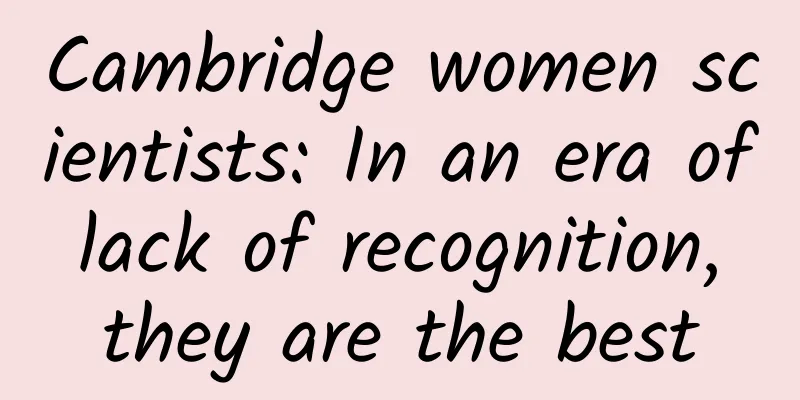Cambridge women scientists: In an era of lack of recognition, they are the best

|
In the article "Is he a master of astrophysics, or a stumbling block to the development of the discipline?" recently published in Fanpu, the author tells the story of astrophysicist Eddington taking the "three-legged stool" exam in Cambridge and winning first place. In this historic exam, there were also women who took part and even won, but they did not receive the honor they deserved. Written by Liu Dun Cambridge is a place that cherishes traditions. Most of its traditions are enviable and awe-inspiring, but some seem out of date today. The restrictions and discrimination on women's admission are one example. This tradition mainly comes from the influence of monastic culture. For centuries, although many queens and noble ladies have become the founders, sponsors and patrons of Cambridge University, there has been no trace of women in the college. Even distinguished female visitors need special permission from the dean to enter the courtyard. Until the 17th century, some colleges still stipulated that maids under the age of 55 were not allowed to be employed. Students' clothes must be placed at the entrance of the college, and the laundry workers will take them away and return them. In the 19th century, the seeds of the feminist movement began to sprout, and two colleges exclusively for female students, Newnham and Girton, appeared in Cambridge. In the process of whether to recognize them as members of the university, the university, the college and the entire town experienced fierce disputes. Even if the women's colleges were eventually accepted by the university, they still did not have the right to award degrees for a long time. The reason is very absurd: women are not suitable for academic activities and are unable to compete with men. Moreover, the school’s library, well-equipped laboratories and most lectures are not open to girls, and school-level awards and scholarships also exclude girls. Girton College and its main founder Emily Davies丨Image source: wiki How can women let men In 1881, the university reluctantly agreed to open some courses and examinations to women, but they were still not given degrees, and even in famous examinations, they did not receive the honors they deserved. The Cambridge Mathematical Honors Examination (Tripos, literally "three-legged stool examination") is a daunting intellectual challenge. For example, in 1854, the examination paper was as long as 16 pages, with a total of 211 questions, and the examination lasted for 8 consecutive days, a total of 44.5 hours. The annual examination has also become a battlefield for those ancient colleges to compete secretly, and the ceremony of announcing the results held in the Council Hall has become a local grand ceremony. The list of winners and their deeds will appear in national newspapers such as The Times, and those mathematical geniuses who topped the list will become household heroes overnight. Famous “Three-legged Stool” champions (also translated as Senior Wranglers) in the Victorian era include John Herschel (1813), George Airy (1823), George Stokes (1841), Arthur Cayley (1842), John Couch Adams (1843), and Lord Rayleigh (John Strutt, 1865); the second place (2nd Wrangler) include George Peacock (1813), William Whewell (1816), Lord Kelvin (William Thomson, 1845), James Maxwell (James Maxwell, 1854), George Darwin (George Darwin, 1868) and Joseph John Thomson (Joseph John Thomson, 1880), etc. In 1881, Charlotte Scott, a girl from Girton College, "informally" participated in the "Three-legged Stool" exam and ranked eighth in total. Since there was a rule in advance that girls were ranked separately, her official score was "between the seventh and eighth", but she could not participate in the ceremony of unveiling the list in the review hall. According to eyewitness records, after the host announced the name and score of the seventh place, the audience shouted "Girton, Scott" in unison. That night, Girton College held a grand celebration dinner for Scott, and the teachers and students present sang "Look, the victorious hero returns" from Handel's oratorio "Judas Maccabee". In fact, Scott's instructor was the great mathematician Cayley (the top scorer of the "Three-legged Stool" in 1842), but her achievements were still ignored by those conservative old colleges, and she later served as a mathematics lecturer at Girton College until 1884. At about the same time, Scott obtained a master's and doctoral degree through the external examinations of the University of London - Cambridge did not open its doors to women until 1948. In 1885, Scott moved to the United States and became the head of the mathematics department at Bryn Mawr College near Philadelphia. He mainly studied high-dimensional algebraic curves and was elected vice president of the American Mathematical Society in 1906. Another female winner of the Mathematics Honours exam was Philippa Fawcett from Newnham College, who took the exam in 1890 and scored 13% higher than the second place. Again due to the stupid rule of separating the scores of boys and girls, she did not receive the title of "Senior Wrangler", but was only announced as having a higher score than the top scorer of the year when the girls' scores were announced. Fawcett's father was a professor of political economy at Cambridge University, and also served as postmaster general and member of the House of Commons; her mother was an early feminist activist and participated in the creation of Newnham College. Fawcett's deeds greatly inspired the feminist movement in Britain in the late 19th century, but she still could not find a suitable position in a top British university. After the Anglo-Boer War in the early 20th century, she took the initiative to teach in South Africa, and after returning to the country, she was responsible for education work in the London County Council. Philippa Fawcett | Image source: wiki Female Nobel Prize winners from Cambridge In 1932, an Oxford girl named Dorothy came to Newnham College, Cambridge, to do her doctoral research under John Desmond Bernal of the Cavendish Laboratory. Bernal was an authority in the new field of X-ray crystallography at the time. Thanks to his and other scientists' efforts, X-ray crystallography became a widely used tool and played a key role in determining the structure of biological molecules. Bernal was also a member of the British Communist Party who was concerned about social issues and enthusiastic about political activities. Perhaps his interests were too broad, and he ultimately failed to go further in the promising intersection of crystallography and molecular biology. However, his beloved disciple and girlfriend Dorothy won the 1964 Nobel Prize in Chemistry for her achievements in confirming the structure of penicillin and deciphering the structure of vitamin B12. Five years after winning the award, Dorothy deciphered the structure of insulin. Dorothy is also regarded as one of the pioneers in using X-ray crystallography to study the structure of protein macromolecules. Despite her close relationship with Bernal, Dorothy neither married him nor joined the Communist Party (although she was a more radical leftist in politics). Dorothy was elected a member of the Royal Society in 1947 and received the Order of Merit from the British royal family in 1965. In 1937, Dorothy married Oxford historian Thomas Lionel Hodgkin, who was also a member of the British Communist Party, but not as obsessed with ideology as Bernard. Dorothy kept her last name for 12 years until 1949 when she changed it to her husband's. Today, general documents refer to her as Dorothy Hodgkin. Dorothy visited China many times and had close exchanges with Chinese scientists such as Liang Dongcai of the Institute of Biophysics of the Chinese Academy of Sciences. She also visited the Soviet Union and North Vietnam, which was bombed by American planes, many times, but she was never welcomed by the US government. In 1971, Dorothy took a photo with local female militia during her visit to North Vietnam. Image source: Ferry (1998) In 1977, Dorothy and Chinese biophysicists (chemists) were comparing the crystal structure of insulin. Image source: Ferry (1998) Another female Nobel Prize winner from Cambridge is Elizabeth Blackburn, who received her doctorate from Darwin College in 1975. Blackburn was born in Australia and later moved to the United States, where she worked at Yale, Berkeley, and the University of California, San Francisco. She won the 2009 Nobel Prize in Physiology or Medicine with Carol W. Greider and Jack W. Szostak for "discovering how telomeres and telomerase protect chromosomes." Greider was a doctoral student she supervised, also a woman; Szostak was a collaborator working at Harvard Medical School. Blackburn has dual citizenship of the United States and Australia, but her foundation in molecular biology was laid during her study in Cambridge, when she specialized in a bacteriophage called Phi X 174. Her doctoral supervisor was Frederick Sanger, the only Cambridge biochemist who has won the Nobel Prize in Chemistry twice. Speaking of the Nobel Prize, perhaps the most important person to mention is Rosalind Elsie Franklin, although she did not wear the crown. Franklin was born into a wealthy Jewish intellectual family in London. In 1938, she entered Cambridge to study chemistry and belonged to Newnham College. Before Cambridge officially awarded her degree, she only had a "decree titular degree". During World War II, Franklin studied the special properties of coal and graphite and obtained a doctorate degree. In 1951, she began to study X-ray crystal diffraction and the chemical structure of DNA at King's College, University of London, but she had a misunderstanding with Maurice Wilkins, who was originally in charge of this work: Wilkins thought she was his subordinate, while Franklin thought her work was assigned by the team leader, physicist John Randal. Wilkins called Franklin "Dark Lady" in a private letter, which shows that the relationship between the two was very tense. Around 1951, several laboratories in Britain and the United States were engaged in research on the molecular structure of genetic material. Franklin did some important work during this period, including an X-ray crystal diffraction photo of B-type DNA obtained in May 1952, which was later called Photo 51 by Bernardus "the most beautiful X-ray image ever". In January of the following year, Wilkins gave the photo to Watson without Franklin's knowledge, and the latter and Crick immediately restarted the construction of the DNA double helix model that was almost in a desperate situation. In 1962, Watson, Crick and Wilkins won the Nobel Prize in Physiology or Medicine for the discovery of the DNA double helix model, while Franklin had passed away four years ago. Many professionals believe that if the Nobel Prize had been awarded to the DNA double helix model earlier or Franklin was still alive, the final winners would have been Crick, Franklin and Watson. (Editor's note: See "70 years ago today, the paper that changed the life sciences was published" and "When I arrived at this bar, I thought of her") In 1968, Watson published a controversial bestseller, The Double Helix, in which Franklin was described as a weird woman with no feminine charm, who didn't know how to dress and was very scheming. He also mistakenly said that Franklin was Wilkins' subordinate and guessed that her family life was unhappy, etc. (If there was no "political correctness", the outspoken Watson might have said things like "Jew" and "old girl"). Watson's book was criticized by many people, and he later expressed his respect for Franklin on different occasions. In the eyes of Bernard, who recruited her to Birkbeck College and witnessed her spend five happy and productive years, Franklin was a completely different image. In his obituary published in Nature magazine, he wrote: "As far as scientists are concerned, the most special thing about Miss Franklin is that every work she does is extremely thorough and perfect. The photos she took (referring to Photo 51) can be listed as one of the most beautiful X-ray photos ever." Looking at the photos below, we can see that Watson's portrayal is biased, and Bernard's description of "thoroughness", "perfection" and "beauty" is not limited to Franklin's academic work. Franklin at work (left: 1949; right: 1955) | Image source: US National Library of Medicine Left: Mountaineering in Norway (1940s); Right: Traveling in Tuscany, Italy (1950) | Image source: US National Library of Medicine Today, about half of Cambridge University's undergraduates are female, and the proportion of female postgraduates is about 40%. There are also many famous female professors, scholars and managers. In 2003, Cambridge University elected the first female full-time vice-chancellor in history (the president of Cambridge University is only a ceremonial honorary title. The president at that time was the Duke of Edinburgh, the husband of Elizabeth II), anthropologist Alison Richard. During her tenure, Cambridge University held a grand celebration of its 800th anniversary in 2009. According to 2017 data, 11 of the 31 colleges of Cambridge University are headed by women, including the oldest Peterhouse College, which is the second-to-last Cambridge college to accept female students. Things change so fast and it is hard to predict what will happen in this world. The old stubborn people who tried their best to prevent women from entering Cambridge University must be sighing and lamenting that people’s hearts have changed. Related readings [1] Grinstein, L. & Campbell, P. 1987. Women of Mathematics: A Biobibliographic Sourcebook. New York: Greenwood Press. [2] Georgina, F. 1998. Dorothy Hodgkin: A Life. London: Granta Books. [3] Maddox, B. 2003. Rosalind Franklin: The Dark Lady of DNA. New York: Harper Collins. [4] Brady, Catherine. 2007. Elizabeth Blackburn and the Story of Telomeres: Deciphering the Ends of DNA. Cambridge MA: MIT Press. This article was originally published in the March 9, 2018 issue of China Science Daily and was authorized by the author to be published in Fanpu with slight modifications. Special Tips 1. Go to the "Featured Column" at the bottom of the menu of the "Fanpu" WeChat public account to read a series of popular science articles on different topics. 2. Fanpu provides a function to search articles by month. Follow the official account and reply with the four-digit year + month, such as "1903", to get the article index for March 2019, and so on. |
<<: Why can I finish two bowls of rice after swimming, but have no appetite after running?
>>: Arthritis is not caused by freezing, but I still advise you to wear long johns
Recommend
A guide to placing game ads on Toutiao today!
On Toutiao , there are 50 million people who play...
Does Tudou.com need authorization to use Renren Films subtitles?
Recently, Renren Film Subtitle Group posted a mic...
Digital Human Lights the Main Torch of the Hangzhou Asian Games! The First in Asian Games History! How Did It Happen?
On September 23, 2023, at the opening ceremony of...
Celebrities strongly recommend the "Happy Fast Slimming Zumba Dance" which everyone can dance to, which can burn fat, easily lose weight and dance sexy
Celebrities strongly recommend the "Happy Fa...
With the right channels and prices, your product is still not well received?
Nowadays, procrastination has become a social pro...
The Cocos Developer Platform White Paper will be officially released on October 28
[[121407]] <span lang="EN-US" style="font-size...
Is superluminal travel really coming? The first curvature bubble has been discovered, and there is hope for warp drive research
The speed bottleneck limits the pace of human exp...
Tencent WeChat Enterprise Account starts public beta testing to provide mobile application access
Recently, Tencent's WeChat Enterprise Account...
Sleeping an extra hour a day can help you lose 20 pounds! Has a completely painless way to lose weight been found?
Reviewer of this article: Chen Haixu, Deputy Dire...
How to prevent violations during live broadcasts?
Live streaming , using direct narration instead o...
Alibaba IPO: 5 big winners and 5 big losers
According to foreign media reports, Alibaba offic...
Private domain operation strategy for beauty brands!
Preface As the vanguard of the new brand wave, th...
"Indian Traditional Yoga" Advanced Course丨Combination of Body and Mind
Introduction to the resources of "Traditiona...
Momo information flow advertising skills, play with pan-entertainment social information flow advertising!
Written in front Momo is a pan-entertainment soci...
When did Audi start making new energy vehicles? The answer is 100 years ago!
It is inevitable for luxury brands to enter the e...









